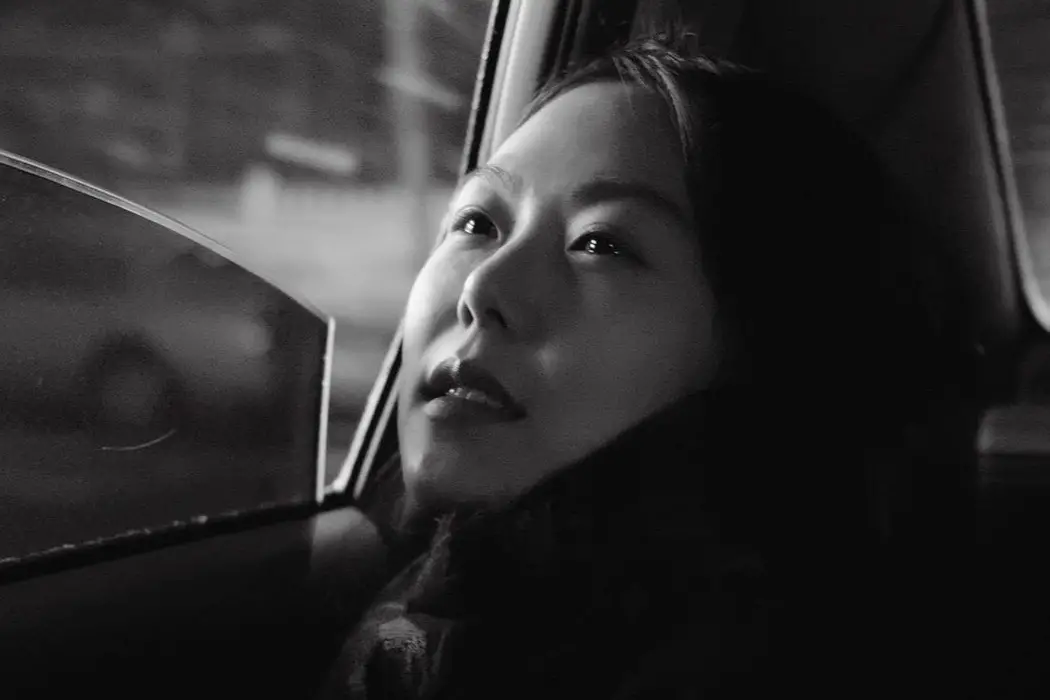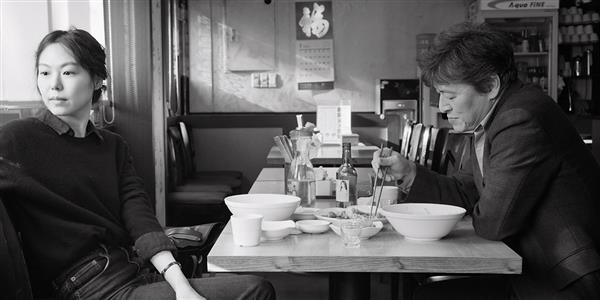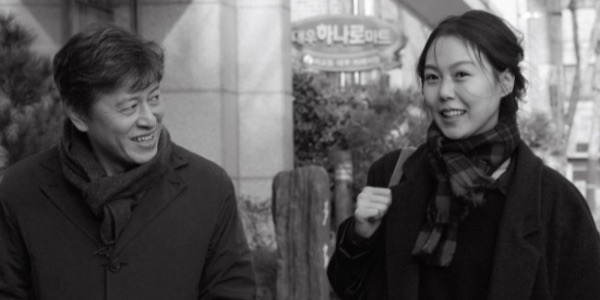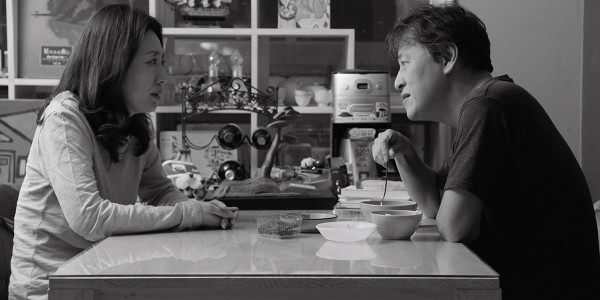THE DAY AFTER: Adventures In Autocritique

Midwesterner, movie lover, cinnamon enthusiast.
The majority of Hong Sang-soo’s The Day After takes place over a couple days in the life of Bongwan (Kwon Hae-hyo), a small publisher lamenting the passing of his most recent affair. He gets day-drunk with his newly hired assistant, Areum (Kim Min-hee), whom, we quickly get the feeling, might have been hired under the prospect of being his next mistress.
Though The Day After isn’t a jarring transition from Hong’s previous film, the effervescent Claire’s Camera, a mournful cloud hangs over this one, appropriately shot in digital monochrome.
Hong’s Style
As melodramatic a premise, make no mistake: Hong makes mundane, decaffeinated films that advance with a tempo out of step with the contemporary film landscape. Driven by long, casual conversations in ordinary spaces and between men and women who often don’t know each other very well, they can make My Dinner With Andre look like Mad Max: Fury Road.

The mundanity is further punctuated by Hong’s allergy to cutting from master shots, letting one medium close-up shot go on for minutes during a discussion. These aren’t the challenging, ornate, Tarkovskian long takes lionized by Film School Joe, but pendulumic pans that carry the weight and inevitability of a carnival’s pirate ship ride. Most likely, these master shots are born out of a personal adherence to a filmmaking ethos of efficiency and simplicity.
As a result of such a unique aesthetic profile, it’s safe to say mileage may vary for viewers. For instance, in his review of The Day After, The A.V. Club’s Mike D’Angelo said, “Hong’s use of the camera has strayed into autopilot territory, randomly panning from one actor to the other over the course of long, repetitive, faintly dull conversations (including one earnest undergrad-style bull session about the nature of reality and whether it can be captured in words).”
A Playful Structure
The film’s structure is up for questioning. Its timeline repeatedly invites you to read it as nonlinear, right before pulling back the curtain, giving us reason to think it’s actually straightforward. Towards the end of the film, Bongwan runs into Areum after not seeing each other for a while; they have an almost identical conversation as the day they first met.
As the conversation goes on, Areum realizes Bongwan just doesn’t remember her. Before the moment they reconcile his forgetfulness, the scene invites viewers to wonder if this is a reimagining of their first meeting. Hong invites the same questioning with what appears to be inter-stitched flashbacks to Bongwan’s affair, but then are contextualized within the straightforward narrative when a character from the present narrative shows up.
Guy Lodge called this Hong’s favorite narrative party trick, I have to believe this is more than a gimmick for Hong — that perhaps he’s playing with the idea of how we make sense of our own narratives. Bongwan has a long conversation about reality and whether it’s something you can concretely make sense of (the one D’Angelo deemed undergrad-worthy). With this playful linearity, I suspect the film’s form is a reflection of the lack of fidelity inherent in our sense of reality. Trying to figure out whether what we’re experiencing is happening now, or whether it has already happened, gives the viewer an articulation of Areum’s debate.

In my review of Claire’s Camera , I said that frequent Eric Rohmer comparisons aren’t unearned, but that Hong isn’t as diegetically philosophical. This long conversation between Areum and Bongwan, on faith and reality, is the closest I’ve seen Hong hew towards Rohmer -esque dialogue, and frankly, he’s just not as good at it, but the scene does set up a wonderful payoff for Areum later in the film.
A World Without Causality
For Reverse Shot, Nick Pinkerton makes a convincing case that Hong ’s narrative muddying is less conceptual and more a symptom of Hong ’s overarching ethos, saying that his films “seem to turn away from the very idea that there is anything to build toward, in either life and in art: things happen and then more things happen. Even his ‘sliding door’ alternate narratives diminish the power of causality: things happen, but things might happen in another way, but then it wouldn’t make all that much difference if they did .”
“Diminishing the power of causality” might be the most succinct encapsulation of Hong ’s films. It might sound anarchic to skeptics, but I don’t get the sense Hong is looking to win anyone over. In fact, in the same piece, Pinkerton calls Hong the cinephile’s ideal filmmaker, “which is to say that his movies are directly referential to the conditions of cinephile culture, because by Hong ’s own testimony he makes personal films about what he knows, and what he knows is evidently making movies and touring the movies he makes.”
In other words, his films are intimate and nothing if not personal, attracting viewers who are distinctly interested in movies that are distillations of an artist’s vision. If you’re skeptical of Hong ’s work, chances are you won’t be returning, unless you’re the type to wrestle with work that like-minded fim fans praise, no matter how frustrating you find it.

That said, this being my third viewer Hong film, I found that I had calibrated my expectations of how a Hong film works, thereby allowing me to sink into his style more quickly than previous viewings. Because I know that he only secures a few locations, I recognize that once two people are sitting in front of us in a restaurant or shop, we’re gonna be here awhile, watching them chat. And because I know of the director’s fondness for master shots, I’m not expecting edits the way I would would most films. Hong’s priorities are different from other filmmakers; he eschews an adherence to film language decorum in favor of interrogating emotions and ideas that are important to him, in ways that make sense to him.
Apparently, causality doesn’t make sense to him. As Pinkerton noted, his films don’t build toward anything. When they end, they end, without pomp and circumstance nor grand realizations. I find this approach comforting, formally, perhaps because his films exist outside of an accepted pretense of cinema — of known beginnings, ends and causes.
Perhaps refreshing is a better descriptor than comforting, because however consoling in form, Hong’s films certainly don’t trend toward comforting subject matter. In fact, taking an autobiographical lens to Hong’s films could only end in a damning autocritique — in The Day After , that looks like an insular, day-drunk womanizer who uses his publishing house (or, Hong’s film productions) as a carousel for young women he’d like to sleep with.
The Day After: Conclusion
There’s an admirable honesty in films like The Day After and Claire’s Camera , especially considering how public his extra-marital affair with Kim Min-hee is, and that honesty is neither navel-gazing nor self-aggrandizing; instead, it achieves an unfiltered examination.
When Bongwan doesn’t remember Areum, it’s not a narrative party trick, but a claim that this woman is the same as the last and the same as the next one. Hong doesn’t see this man changing his habits anytime soon. Though Bongwan has plenty to be guilty about, guilt isn’t always the best catalyst for change, and more importantly, sometimes change just doesn’t happen.
Have you seen The Day After? Tell us your thoughts in the comments below!
The Day After was released in the US on May 11, 2018. For all international release dates, see here.
Does content like this matter to you?
Become a Member and support film journalism. Unlock access to all of Film Inquiry`s great articles. Join a community of like-minded readers who are passionate about cinema - get access to our private members Network, give back to independent filmmakers, and more.













